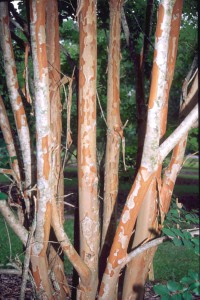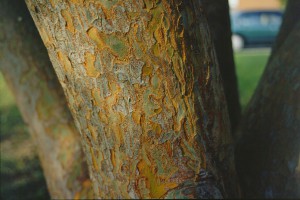From about mid November or December to March, deciduous trees have little to no foliage making us more aware of their shapes, forms and barks.
Here are a few trees to consider for adding winter appeal to your landscape.
Gary Knox, UF/IFAS Horticulturist, describes the crapemyrtle’s winter interest perfectly in his publication, “Crapemyrtle in Florida.” Knox writes, “When the leaves fall in winter, the crape myrtle becomes a living sculpture. The trunk and branches of tree-form plants have an attractively gnarled, sinuous character with smooth bark. Strips of bark peel off (exfoliate) in early summer to reveal mottled new bark ranging in color from pale cream to dark cinnamon to rich brown to bright orange.”
Here are some recommendations for crapemyrtles with attractive bark. ‘Acoma’ is an outstanding semi-dwarf hybrid reaching a mature height of 10 to 15 feet that has creamy beige bark and snow white flowers. ‘Apalachee’ is another outstanding selection with cinnamon orange bark and light lavender flowers. Its mature height is about 20 feet. The cultivar ‘Osage’ produces dark orange bark and medium pink flowers with a 20-foot mature height. ‘Fantasy’ is a large maturing variety growing to more than 20 feet tall with outstanding red orange bark and white flowers. More cultivars are listed in Knox’s publication available at http://edis.ifas.ufl.edu/MG266.
River birch is another tree with unusual papery peeling bark. The cultivar ‘Heritage’ is the closest to a paper white birch that will tolerate our hot summers. Expect a river birch to reach 40 to 50 feet in height and 25 to 35 feet in width.
Cultivars of Ulmus parvifo
lia, Chinese elm, provide winter interest. “The showy, exfoliating bark reveals random mottled patterns of gray, green, orange and brown, adding great textural and visual interest, especially to its winter silhouette,” writes Ed Gilman, UF/IFAS Horticulturist, in his factsheet on Chinese Elm. This and other tree factsheets are available at http://hort.ifas.ufl.edu/woody. ‘Drake’ and ‘Allee’ are two popular Chinese elm cultivars. Chinese Elm can reach 80 feet in height but is more often seen at 40 to 50 feet with an equal spread.
American Hophornbeam, Ostrya virginiana, is an underused tree that grows to about 50 feet in height. Its grayish bark peels off in longitudinal strips revealing orange patches underneath.
Acer buergeranum or trident maple is a small, underused and hard to find tree. It usually is seen with multiple stems originating fairly low on the trunk giving the small tree a bushy appearance. It has noticeable orange-brown peeling bark.
- Christmas Plants can be Enjoyed Beyond the Holidays - December 13, 2024
- Water Management during Dry Weather - October 31, 2024
- Fall Takes Toll on Leaves at End of Life - September 19, 2024


